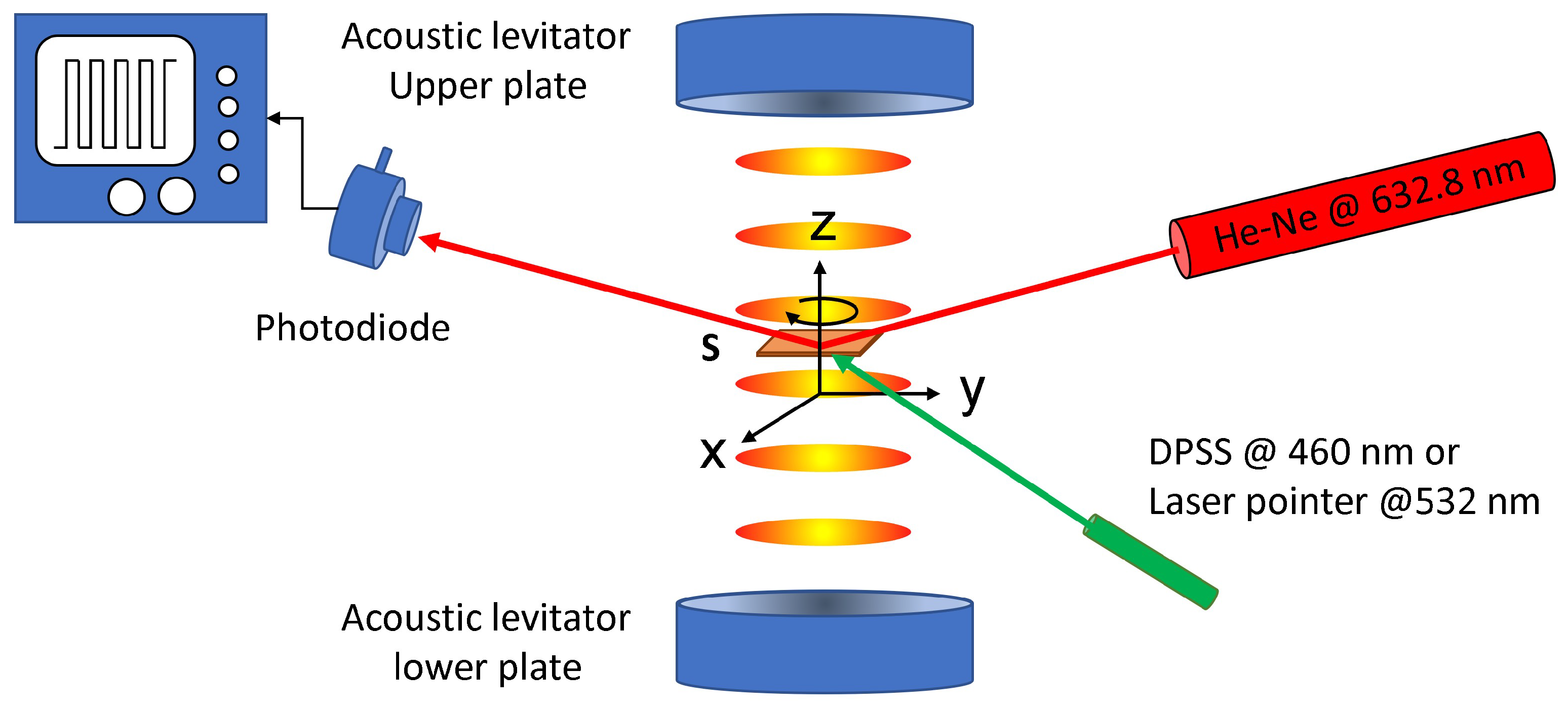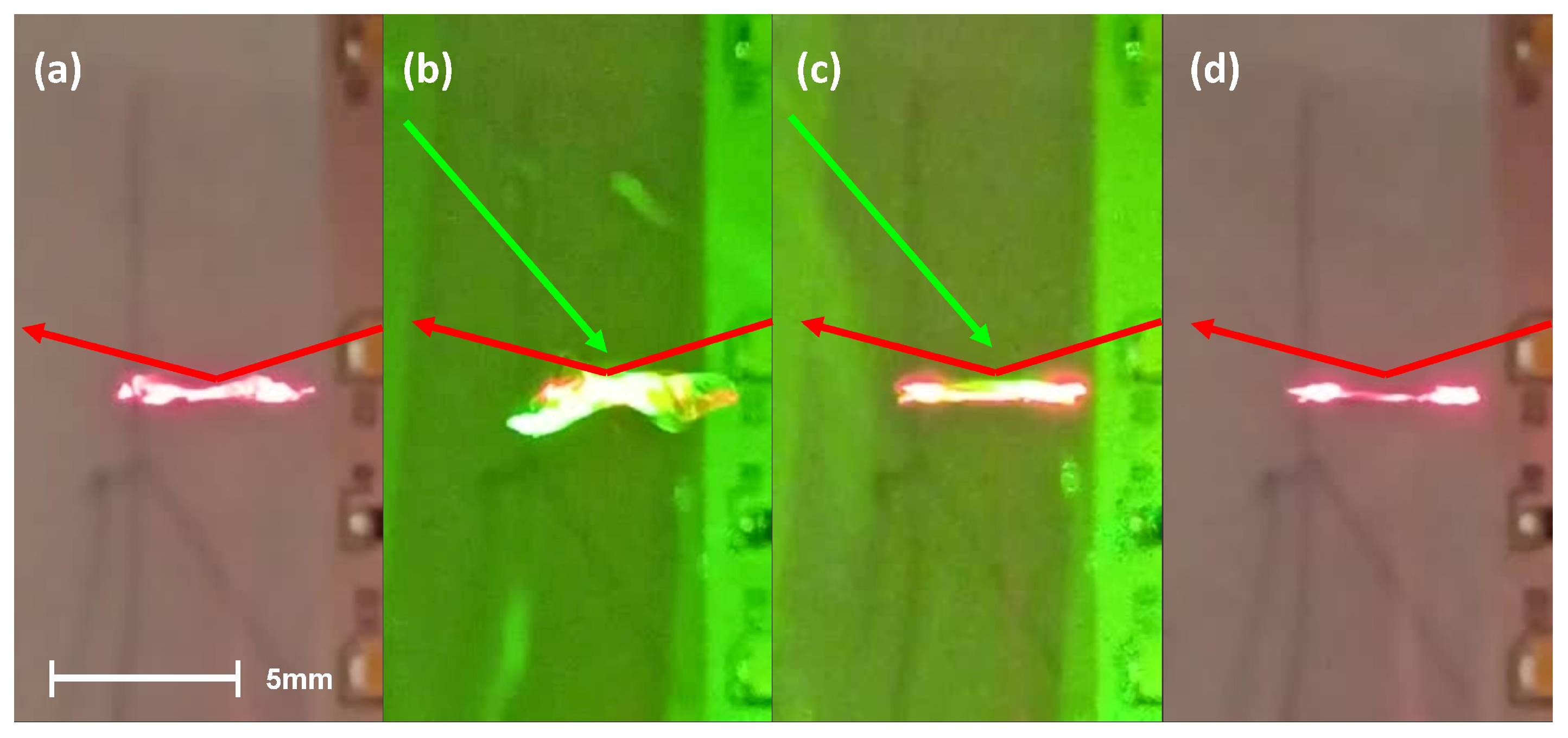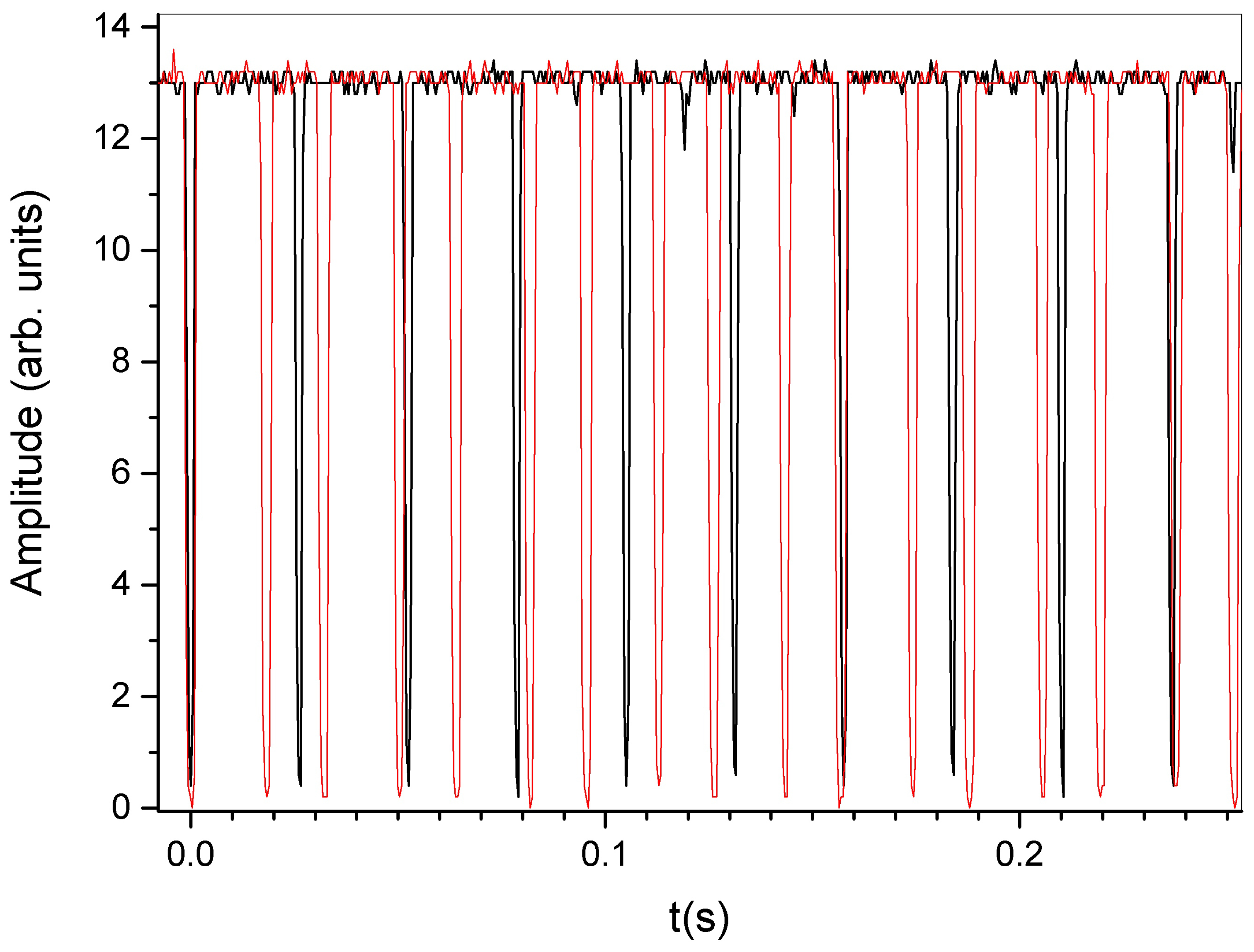Light-Controlled Rotational Speed of an Acoustically Levitating Photomobile Polymer Film
Abstract
1. Introduction
2. Materials and Methods
2.1. Materials
2.2. PMP-Mixture Preparation
2.3. PMP-Film Preparation
2.4. Optical Setup
3. Results and Discussion
4. Conclusions
Supplementary Materials
Author Contributions
Funding
Institutional Review Board Statement
Informed Consent Statement
Data Availability Statement
Conflicts of Interest
References
- Kepa, M.W.; Tomizaki, T.; Sato, Y.; Ozerov, D.; Sekiguchi, H.; Yasuda, N.; Aoyama, K.; Skopintsev, P.; Standfuss, J.; Cheng, R.; et al. Acoustic levitation and rotation of thin films and their application for room temperature protein crystallography. Sci. Rep. 2022, 12, 5349. [Google Scholar] [CrossRef] [PubMed]
- Foresti, D.; Poulikakos, D. Acoustophoretic Contactless Elevation, Orbital Transport and Spinning of Matter in Air. Phys. Rev. Lett. 2014, 112, 024301. [Google Scholar] [CrossRef] [PubMed]
- Marzo, A.; Caleap, M.; Drinkwater, B.W. Acoustic Virtual Vortices with Tunable Orbital Angular Momentum for Trapping of Mie Particles. Phys. Rev. Lett. 2018, 120, 044301. [Google Scholar] [CrossRef] [PubMed]
- Melde, K.; Mark, A.G.; Qiu, T.; Fischer, P. Holograms for acoustics. Nature 2016, 537, 518–522. [Google Scholar] [CrossRef] [PubMed]
- Ochiai, Y.; Hoshi, T.; Rekimoto, J. Three-Dimensional Mid-Air Acoustic Manipulation by Ultrasonic Phased Arrays. PLoS ONE 2014, 9, e97590. [Google Scholar] [CrossRef]
- Hirayama, R.; Martinez Plasencia, D.; Masuda, N.; Subramanian, S. A volumetric display for visual, tactile and audio presentation using acoustic trapping. Nature 2019, 575, 320–323. [Google Scholar] [CrossRef]
- Tang, T.; Silva, G.T.; Huang, L.; Han, X. Acoustic levitation of axisymmetric Mie objects above a transducer array by engineering the acoustic radiation force and torque. Phys. Rev. E 2022, 106, 045108. [Google Scholar] [CrossRef]
- Ezcurdia, I.N.; Morales, R.; Andrade, M.A.B.; Marzo, A. LeviPrint: Contactless Fabrication Using Full Acoustic Trapping of Elongated Parts. In Proceedings of the ACM SIGGRAPH 2022 Conference Proceedings (SIGGRAPH ’22), Vancouver, BC, Canada, 7–11 August 2022; Association for Computing Machinery: New York, NY, USA, 2022. [Google Scholar] [CrossRef]
- Andrade, M.A.B.; Okina, F.T.A.; Bernassau, A.L.; Adamowski, J.C. Acoustic levitation of an object larger than the acoustic wavelength. J. Acoust. Soc. Am. 2017, 141, 4148–4154. [Google Scholar] [CrossRef]
- Biswal, T.; BadJena, S.K.; Pradhan, D. Synthesis of polymer composite materials and their biomedical applications. Mater. Today Proc. 2020, 30, 305–315. [Google Scholar] [CrossRef]
- Lucchetta, D.; Spegni, P.; Di Donato, A.; Simoni, F.; Castagna, R. Hybrid surface-relief/volume one dimensional holographic gratings. Opt. Mater. 2015, 42, 366–369. [Google Scholar] [CrossRef]
- Tuttle, M. Structural Analysis of Polymeric Composite Materials, 2nd ed.; Chapman Hall/CRC Applied Env, Taylor & Francis: Boca Raton, FL, USA, 2012. [Google Scholar]
- Tsuchiya, H.; Asaki, Y.; Sinawang, G.; Asoh, T.A.; Osaki, M.; Park, J.; Ikemoto, Y.; Yamaguchi, H.; Harada, A.; Uyama, H.; et al. Cellulose Nanofiber Composite Polymeric Materials with Reversible and Movable Cross-links and Evaluation of their Mechanical Properties. ACS Appl. Polym. Mater. 2022, 4, 403–412. [Google Scholar] [CrossRef]
- Hsissou, R.; Seghiri, R.; Benzekri, Z.; Hilali, M.; Rafik, M.; Elharfi, A. Polymer composite materials: A comprehensive review. Compos. Struct. 2021, 262, 113640. [Google Scholar] [CrossRef]
- Lucchetta, D.; Vita, F.; Francescangeli, D.; Francescangeli, O.; Simoni, F. Optical measurement of flow rate in a microfluidic channel. Microfluid. Nanofluid. 2016, 20, 9. [Google Scholar] [CrossRef]
- Lucchetta, D.; Simoni, F.; Hernandez, R.; Mazzulla, A.; Cipparrone, G. Lasing from chiral doped nematic liquid crystal droplets generated in a microfluidic device. Mol. Cryst. Liq. Cryst. 2017, 649, 11–19. [Google Scholar] [CrossRef]
- Castagna, R.; Lucchetta, D.E.; Rippa, M.; Xu, J.H.; Donato, A.D. Near-frequency photons Y-splitter. Appl. Mater. Today 2020, 19, 100636. [Google Scholar] [CrossRef]
- Shalit, A.; Lucchetta, D.; Piazza, V.; Simoni, F.; Bizzarri, R.; Castagna, R. Polarization-dependent laser-light structured directionality with polymer composite materials. Mater. Lett. 2012, 81, 232–234. [Google Scholar] [CrossRef]
- Yu, Y.; Nakano, M.; Ikeda, T. Directed bending of a polymer film by light. Nature 2003, 425, 145. [Google Scholar] [CrossRef]
- Zhou, Y.; Wang, L.; Ma, S.; Zhang, H. Fully Room-Temperature Reprogrammable, Reprocessable, and Photomobile Soft Actuators from a High-Molecular-Weight Main-Chain Azobenzene Crystalline Poly(ester-amide). ACS Appl. Mater. Interfaces 2022, 14, 3264–3273. [Google Scholar] [CrossRef]
- Chiellini, E.; Galli, G.; Altomare, A.; Solaro, R.; Angeloni, A.; Laus, M.; Carlini, C.; Caretti, D. Thermotropic and solution photoisomerization properties of side-chain liquid crystalline polymers containing methyl-substituted azobenzene mesogens. Mol. Cryst. Liq. Cryst. Sci. Technol. Sect. A Mol. Cryst. Liq. Cryst. 1992, 221, 61–69. [Google Scholar] [CrossRef]
- Yamada, M.; Kondo, M.; Mamiya, J.I.; Yu, Y.; Kinoshita, M.; Barrett, C.; Ikeda, T. Photomobile Polymer Materials: Towards Light-Driven Plastic Motors. Angew. Chem. Int. Ed. 2008, 47, 4986–4988. [Google Scholar] [CrossRef]
- Ube, T.; Ikeda, T. Photomobile Polymer Materials with Complex 3D Deformation, Continuous Motions, Self-Regulation, and Enhanced Processability. Adv. Opt. Mater. 2019, 7, 1900380. [Google Scholar] [CrossRef]
- Ikeda, T.; Ube, T. Photomobile polymer materials: From nano to macro. Mater. Today 2011, 14, 480–487. [Google Scholar] [CrossRef]
- Koerner, H.; White, T.J.; Tabiryan, N.V.; Bunning, T.J.; Vaia, R.A. Photogenerating work from polymers. Mater. Today 2008, 11, 34–42. [Google Scholar] [CrossRef]
- Castagna, R.; Nucara, L.; Simoni, F.; Greci, L.; Rippa, M.; Petti, L.; Lucchetta, D.E. An Unconventional Approach to Photomobile Composite Polymer Films. Adv. Mater. 2017, 29, 1604800. [Google Scholar] [CrossRef]
- Lucchetta, D.E.; Castagna, R.; Simoni, F. Light-actuated contactless macro motors exploiting Bénard–Marangoni convection. Opt. Express 2019, 27, 13574–13580. [Google Scholar] [CrossRef]
- Lucchetta, D.E.; Simoni, F.; Sheremet, N.; Reshetnyak, V.; Castagna, R. Shape-driven optofluidic rotational actuation. Eur. Phys. J. Plus 2021, 136, 445. [Google Scholar] [CrossRef]
- Lucchetta, D.E.; Di Donato, A.; Francescangeli, O.; Singh, G.; Castagna, R. Light-Controlled Direction of Distributed Feedback Laser Emission by Photo-Mobile Polymer Films. Nanomaterials 2022, 12, 2890. [Google Scholar] [CrossRef]
- Lucchetta, D.; Di Donato, A.; Singh, G.; Tombesi, A.; Castagna, R. Optically tunable diffraction efficiency by photo-mobile holographic composite polymer material. Opt. Mater. 2021, 121, 111612. [Google Scholar] [CrossRef]
- Lucchetta, D.E.; Castagna, R.; Singh, G.; Riminesi, C.; Di Donato, A. Spectral, morphological and dynamical analysis of a holographic grating recorded in a photo-mobile composite polymer mixture. Nanomaterials 2021, 11, 2925. [Google Scholar] [CrossRef]
- Lucchetta, D.E.; Di Donato, A.; Paturzo, M.; Singh, G.; Castagna, R. Light-Induced Dynamic Holography. Micromachines 2022, 13, 297. [Google Scholar] [CrossRef]
- Castagna, R.; Donato, A.D.; Strangi, G.; Lucchetta, D.E. Light controlled bending of a holographic transmission phase grating. Smart Mater. Struct. 2022, 31, 03LT02. [Google Scholar] [CrossRef]
- Castagna, R.; Di Donato, A.; Castaldo, R.; Avolio, R.; Francescangeli, O.; Lucchetta, D.E. Scotch-Tape and Graphene-Oxide Photomobile Polymer Film. Photonics 2022, 9, 659. [Google Scholar] [CrossRef]
- Marzo, A.; Barnes, A.; Drinkwater, B.W. TinyLev: A multi-emitter single-axis acoustic levitator. Rev. Sci. Instrum. 2017, 88, 085105. [Google Scholar] [CrossRef] [PubMed]
- Busse, F.H.; Wang, T.G. Torque generated by orthogonal acoustic waves—Theory. J. Acoust. Soc. Am. 1981, 69, 1634–1638. [Google Scholar] [CrossRef]
- Trinh, E.H.; Robey, J.L. Experimental study of streaming flows associated with ultrasonic levitators. Phys. Fluids 1994, 6, 3567–3579. [Google Scholar] [CrossRef]
- Hasegawa, K.; Abe, Y.; Kaneko, A.; Yamamoto, Y.; Aoki, K. Visualization Measurement of Streaming Flows Associated with a Single-Acoustic Levitator. Microgravity Sci. Technol. 2009, 21, 9–14. [Google Scholar] [CrossRef]



Disclaimer/Publisher’s Note: The statements, opinions and data contained in all publications are solely those of the individual author(s) and contributor(s) and not of MDPI and/or the editor(s). MDPI and/or the editor(s) disclaim responsibility for any injury to people or property resulting from any ideas, methods, instructions or products referred to in the content. |
© 2023 by the authors. Licensee MDPI, Basel, Switzerland. This article is an open access article distributed under the terms and conditions of the Creative Commons Attribution (CC BY) license (https://creativecommons.org/licenses/by/4.0/).
Share and Cite
Lucchetta, D.E.; Castellini, P.; Martarelli, M.; Scalise, L.; Pandarese, G.; Riminesi, C.; Singh, G.; Di Donato, A.; Francescangeli, O.; Castagna, R. Light-Controlled Rotational Speed of an Acoustically Levitating Photomobile Polymer Film. Materials 2023, 16, 553. https://doi.org/10.3390/ma16020553
Lucchetta DE, Castellini P, Martarelli M, Scalise L, Pandarese G, Riminesi C, Singh G, Di Donato A, Francescangeli O, Castagna R. Light-Controlled Rotational Speed of an Acoustically Levitating Photomobile Polymer Film. Materials. 2023; 16(2):553. https://doi.org/10.3390/ma16020553
Chicago/Turabian StyleLucchetta, Daniele Eugenio, Paolo Castellini, Milena Martarelli, Lorenzo Scalise, Giuseppe Pandarese, Cristiano Riminesi, Gautam Singh, Andrea Di Donato, Oriano Francescangeli, and Riccardo Castagna. 2023. "Light-Controlled Rotational Speed of an Acoustically Levitating Photomobile Polymer Film" Materials 16, no. 2: 553. https://doi.org/10.3390/ma16020553
APA StyleLucchetta, D. E., Castellini, P., Martarelli, M., Scalise, L., Pandarese, G., Riminesi, C., Singh, G., Di Donato, A., Francescangeli, O., & Castagna, R. (2023). Light-Controlled Rotational Speed of an Acoustically Levitating Photomobile Polymer Film. Materials, 16(2), 553. https://doi.org/10.3390/ma16020553









